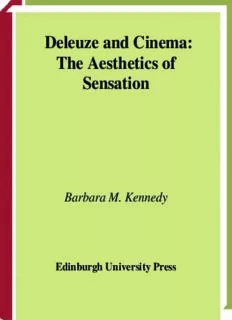
Deleuze and Cinema: The Aesthetics of Sensation PDF
Preview Deleuze and Cinema: The Aesthetics of Sensation
Deleuze and Cinema: The Aesthetics of Sensation Barbara M. Kennedy Edinburgh University Press Deleuze and Cinema Dedications . . . to my loving parents Dorothy Victoria (d. 1993) and William Charles (d. 2000) and, finally, of course . . . to the beautiful stranger . . . Deleuze and Cinema The Aesthetics of Sensation Barbara M. Kennedy Edinburgh University Press # Barbara M. Kennedy, 2000, 2002 Edinburgh University Press Ltd 22 George Square, Edinburgh First published in hardback in 2000. Typeset in 10.5 on 13 Sabon by Hewer Text Ltd, Edinburgh, and printed and bound in Great Britain by MPG Books Ltd, Bodmin A CIP record for this book is available from the British Library ISBN 0 7486 1726 4 (paperback) The right of Barbara M. Kennedy to be identified as author of this work has been asserted in accordance with the Copyright, Designs and Patents Act 1988. Contents Acknowledgements vii Introduction: Discovering the Beautiful Stranger . . . 1 Part One 1 From Micro-politics to Aesthetics 9 2 From Oedipal Myths . . . to New Interventions 38 Part Two 3 From Abstract Machines to Deleuzian Becomings 67 4 Constituting Bodies – from Subjectivity and Affect to the Becoming-woman of the Cinematic 84 5 Towards an Aesthetics of Sensation 108 Part Three 6 Orlando – Deleuzian Landscapes of Immanence 125 7 The English Patient – Deleuzian Landscapes of Immanence 147 8 Romeo and Juliet – Deleuzian Sensations 163 9 Strange Days – Deleuzian Sensations 180 10 Reconfiguring Love . . . A Deleuzian Travesty? Leon and a Molecular Politics via the Girl and the Child 193 Bibliography 215 Filmography 223 Index 225 This page intentionally left blank Acknowledgements I should like to thank the many friends and colleagues from different Deleuzian persuasions, from universities both here, in America and Australia, who have read versions of several chapters in the book. In particular I should like to thank both Helen (Chapman) and Christine (Gledhill) at Staffordshire University, who have both suffered the trials andtribulationsofmywriting,andmypersonae,andofferedadviceand supportat all times. I also want to thank especially David (Bell) and Ian (Buchanan), both of whom saved me from ‘myself’ in times of sheer exasperation and at times even worse, and offered both timely and welcome words in more ways than one. Thanks too must go to Jackie JonesatEdinburghUniversityPress,whorecognisedthepotential,andto Jackie Clewlow, who gave time and energy with secretarial support. Of course I should like to acknowledge the Arts and Humanities Research Board and Staffordshire University for funding and support. And, of course, to those whom I love is a heartfelt thanks for continued support through difficult times. Art is not chaos but a composition of chaos that yields the vision or sensation, so that it constitutes, as Joyce says, a chaosmos, a composed chaos – neither forseen nor preconceived. Art transforms chaotic varia- bility into chaoid variety, as in El Greco’s black and green-gray confla- gration, for example, or Turner’s golden conflagration, or de Stael’s red conflagration.Artstruggleswithchaosbutitdoessoinordertorenderit sensory, even through the most charming character, the most enchanted landscape. (Gilles Deleuze and Fe´lix Guattari, What is Philosophy? p. 204) Introduction Discovering the Beautiful Stranger . . . This book has emerged out of a deliciously dangerous, but delectable journey through the spaces of Deleuzian deterritorialisations. But there are many faces of Deleuze, and I can only engage with a selection: faces from A Thousand Plateaus (1987), Francis Bacon: Logique de la Sensa- tion (1981), Dialogues (1987), What is Philosophy? (1994) and his cinema books1 provide the main lines of flight. I have not used his cinema books as a model for theorising cinema, but have creatively meldedwithawebofDeleuze’swork.Myownlineofflighttookmeona journey into the unknown, where dangers lurked, forced their way into the threshold of my ‘self’ – one already fractured, fragile, faltering and disembodiedfromtoomuchpost-structuralistdestratification. . .thena return to too much phallic and Oedipal anxiety. Film had always been important to my life, my pleasures, my desires. When I encountered the philosopher of difference, new thinking and outside thought enabled creative lines of flight I had never experienced before. This book traces that processual flight; it explores the energies and intensities of ‘flying’ with Deleuzian thoughts and transgressing boundaries of established feminist theory . . . out of bounds! The danger is . . . can I fly forever throughthepathsofindifferenceandinsouciance?Whynot?Orwillthe phallicpaths of culture and academiabring me back to thecontainment of ‘academic theory and the rational mind . . .!’ Deleuze is afigure ofmanycolours, tones,manyintensitiesand many variations, his texts providing vast plateaus and canvases, presenting themselves as screenic events, lines and landscapes of volitional and dynamic concepts, brushstrokes, notes, refrains, digital configurations. Hismultipletexts,andmultiplepersonae,whoarealsonotpersonae,act like heteronyms, puppets or mannequins in the theatre of philosophy, each text contradicting or aligning with others in machinic assemblage, more like a factory, some have said, than a theatre.
Description: